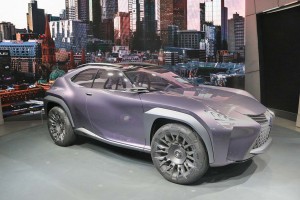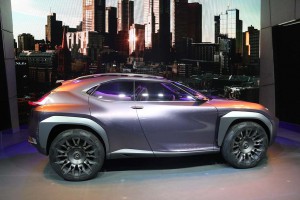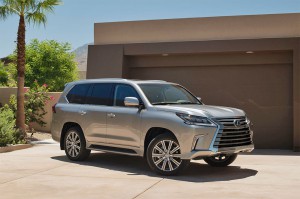
The styling renaissance continues at Lexus with the debut of the UX Concept, although its likely it won't be a "concept" much longer.
Adapting to a rapidly shifting automotive environment, Lexus is reportedly set to transform the UX concept vehicle into its latest production SUV.
First revealed at the Paris Motor Show last September, the UX would join the best-selling RX, the full-size LX, and the relatively new NX in Lexus showrooms. But it could be just one of several new crossovers coming from the Japanese luxury brand, with Lexus also looking at a possible flagship model that would serve as a complement to the LS sedan.
“We are doing (the UX), Lexus Executive Vice President Yoshihiro Sawa told Australia’s Motoring magazine. “It’s not so far away.”
Asked to confirm Sawa’s comments, a senior Lexus spokesperson told TheDetroitBureau.com that, “It’s certainly something that would fit nicely in our line-up but there’s nothing to confirm at this time.”
First seen last autumn in concept form, it’s uncertain how much will change if the UX were to reach production. The small crossover was designed at ED2, the Lexus styling studios in Southern France, and a key goal was to target younger buyers, Sawa noted. That meant going to extremes in the Lexus push to put more “passion” into the brand, as Akio Toyoda, CEO of parent Toyota Motor Corp., has often expressed.
“The biggest challenge for any designer is always to create something new and original, yet with relevance to both the customer and the brand. Overall, this is a product which gives another hint of the potential for Lexus’ design approach to satisfy those criteria,” Simon Humphries, president of ED2, said during the Paris debut of the UX.
(Lexus downsizes with new UX SUV concept. Click Here for the story.)
The show car generated a flurry of controversy, viewers either drawn to – or repelled by – the crossover’s exaggerated mix of creases and curves. A coupe-like roofline was countered by distinctive lines tapering inward from the rear bumper to just below the back glass. Meanwhile, there were winglet-shaped appendages where the traditional sideview mirrors should be. And what appeared to be suicide-style rear doors opened into the flaring back wheel arches.
Those doors aren’t expected to translate into production, nor are the rearview cameras that were apparently fixed into the side stalks.
In fact, Lexus has a history of pushing to the limits with its show cars and then smoothing out some of those sharp angles once it’s time to go to market – as it demonstrated with the earlier NX model. One wag described the original show car version as “six concepts in one.”
At least some key elements of the show car will be certain to carry over into production, however. Lexus described the overall design of the UX concept as “inside-out” styling, a shorthand way of saying it delivers a relatively large cabin despite its compact, entry-lux footprint. Lexus designers explain they wanted to bring together seemingly contrasting goals, creating a crossover with a rugged, 4×4 presence, yet low ground clearance and a coupe-like driving position.
“We were looking for inspiration representing the synergy of contrasting values, in architecture, fashion design or nature, with a view to fusing lightness, structural, artistic and emotional values,” said Stephan Rasmussen, UX Exterior Designer.
(Click Here to see details about Lexus hinting about the UX debut.)
There’s a high-tech yet minimalist feel to the interior, most notably in the form of the Kinetic Seat Concept. It uses a spider web of netting that is flexible enough to mold itself to an occupant’s unique shape. The seats are more supportive, Lexus claims, and yet slimmer and lighter.
That said, expect more traditional seating, rather than the concept’s Kinetic Seat Concept which used a spider web of netting flexible enough to mold itself to an occupant’s unique shape. Nor would we see the hologram-like gauges from the concept. More conventional instrumentation is likely, if for no other reason than the relatively low-end price point a production Lexus UX would have to target.
Work is reportedly already underway on the UX project, and that means we could see it in production within the next year or so, according to various sources. It would go up against an array of new compact crossovers, from the Lincoln MKC to the BMW X1. The segment, while still modest in the U.S. market, is growing rapidly in much of the rest of the world.
While the UX would target the low end of the luxury crossover market, Lexus is looking at opportunities at the upper end, as well, a top-ranking company executive told TheDetroitBureau.com in a background conversation.
The maker is just bringing out an all-new version of its LS sedan, but demand in that niche has been dropping precipitously in recent years, as more and more high-line buyers shift to utes. Audi, for one, plans to bring out a production version of the Q8 crossover it unveiled at the North American International Auto Show in Detroit last January. It will be the counterpoint to the maker’s big A8.
(To see more about thew new Lexus LS, Click Here.)
Lexus is looking at several opportunities. One approach would be to develop an all-new, full-size model. The other would be to completely re-think the current LX line. It’s currently more of an extreme machine for those who need a serious off-roader. It would likely have to migrate to a unibody design and emphasize on-, rather than off-road, credentials. Whichever approach Lexus takes, a new SUV flagship is likely three to four years out.


